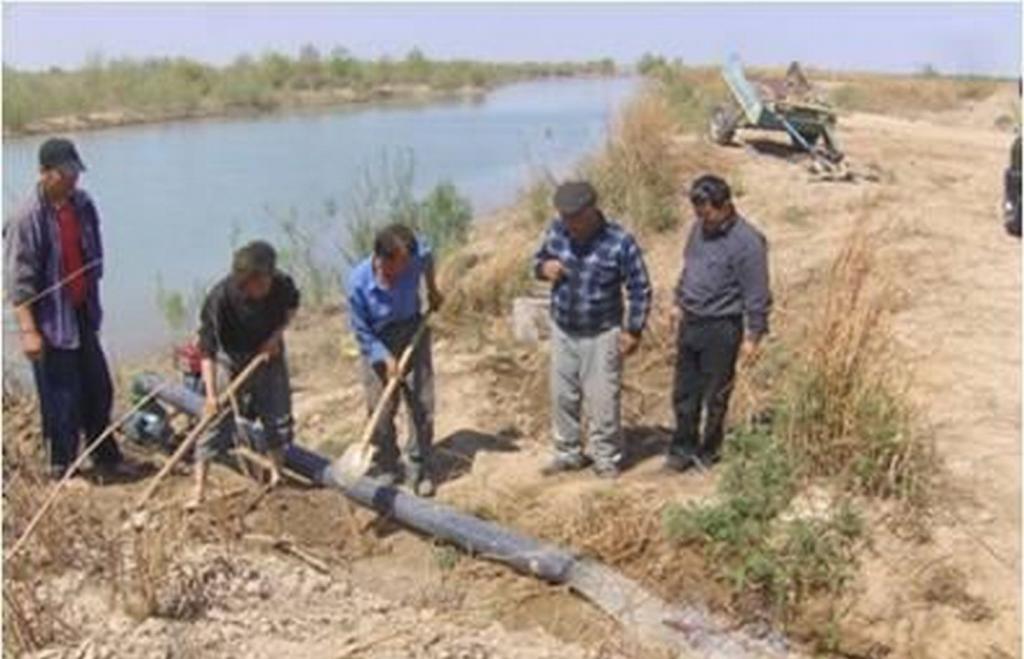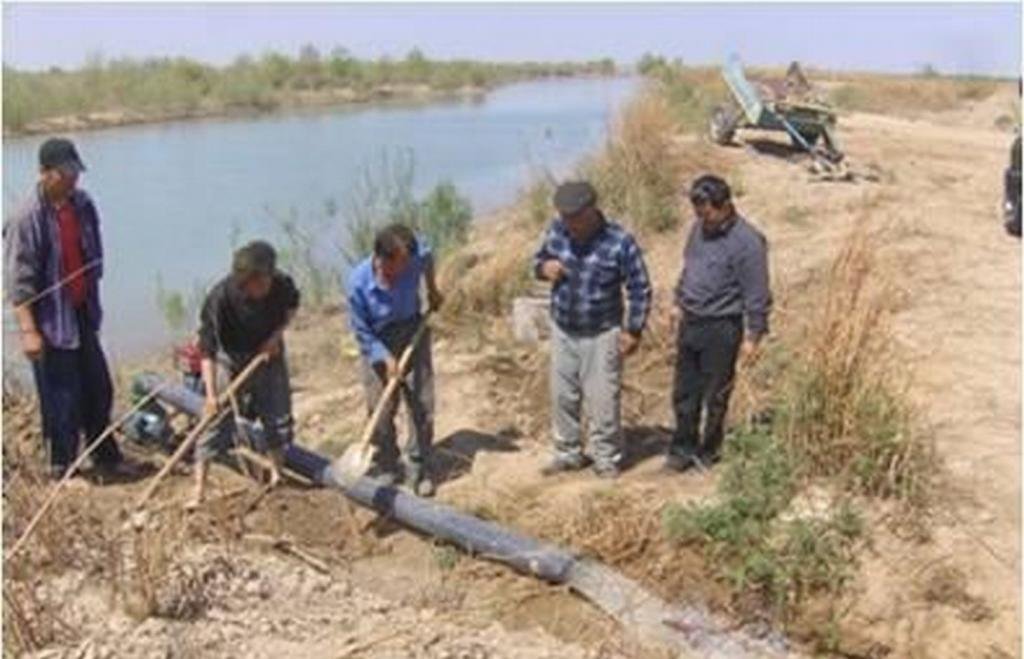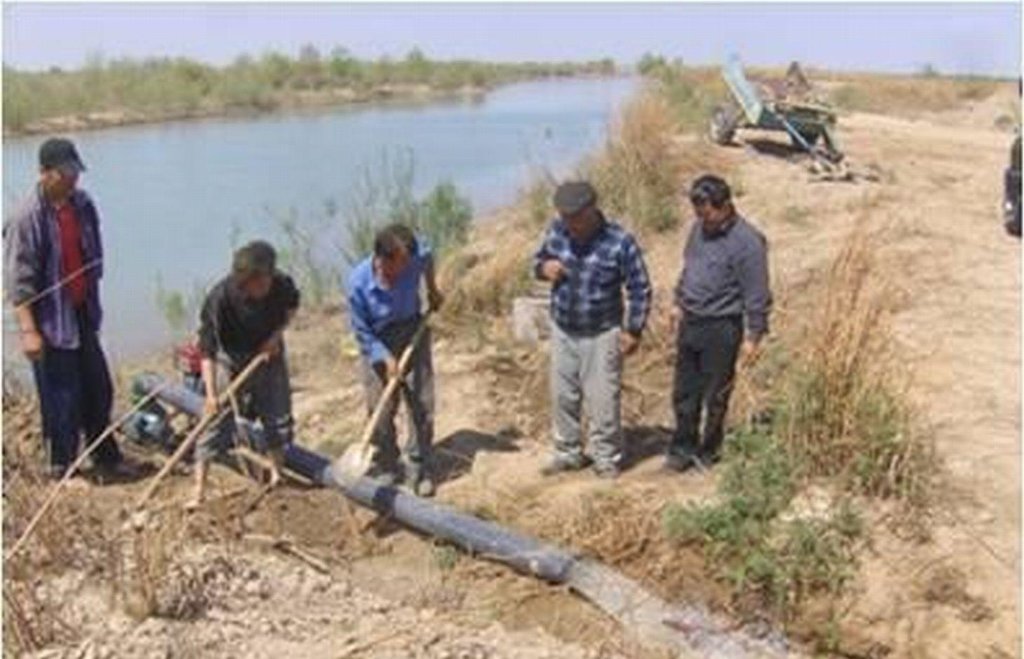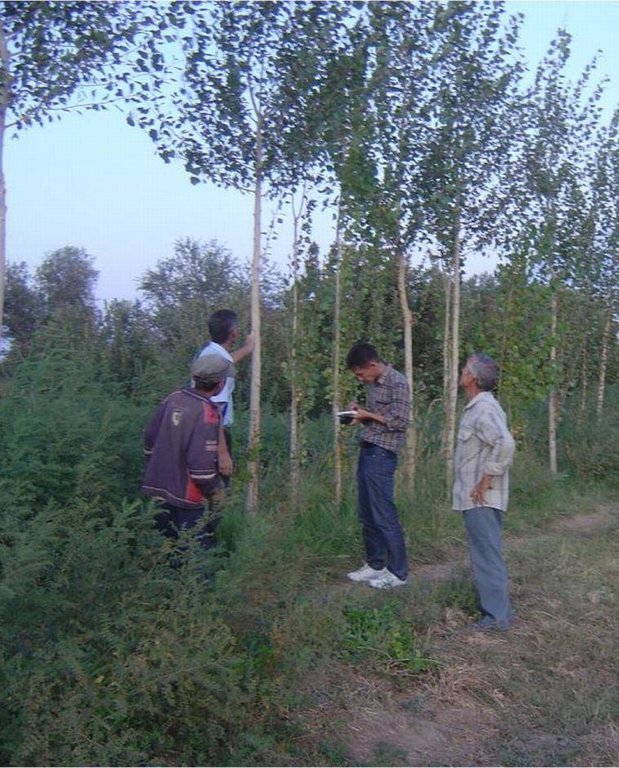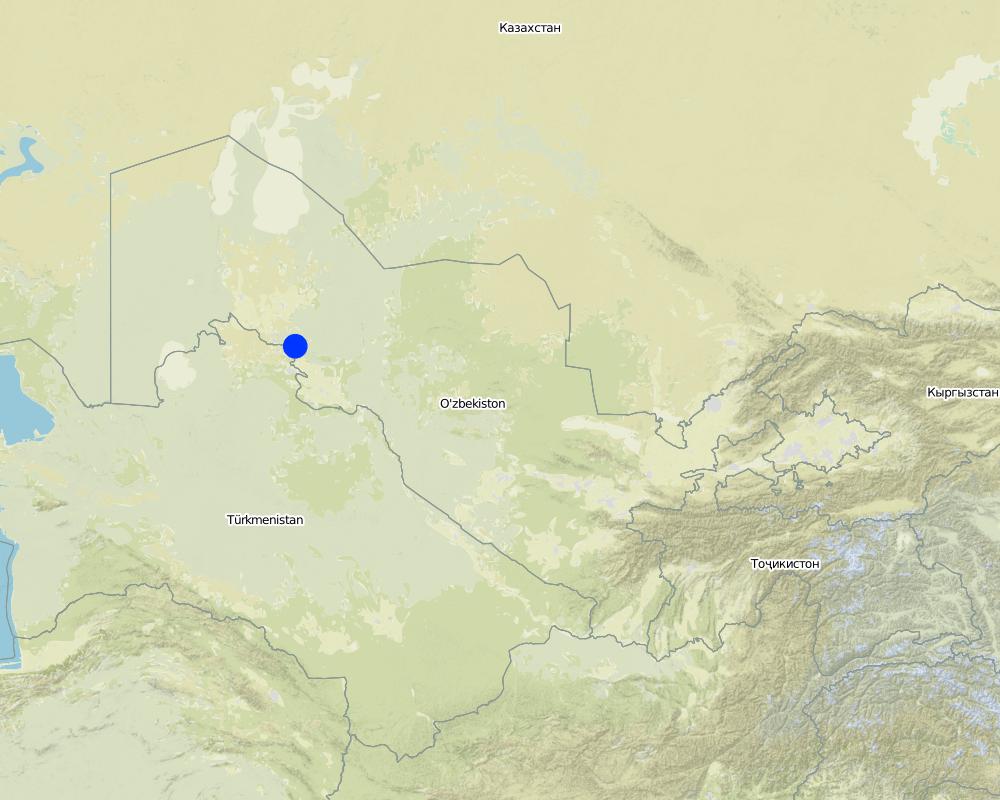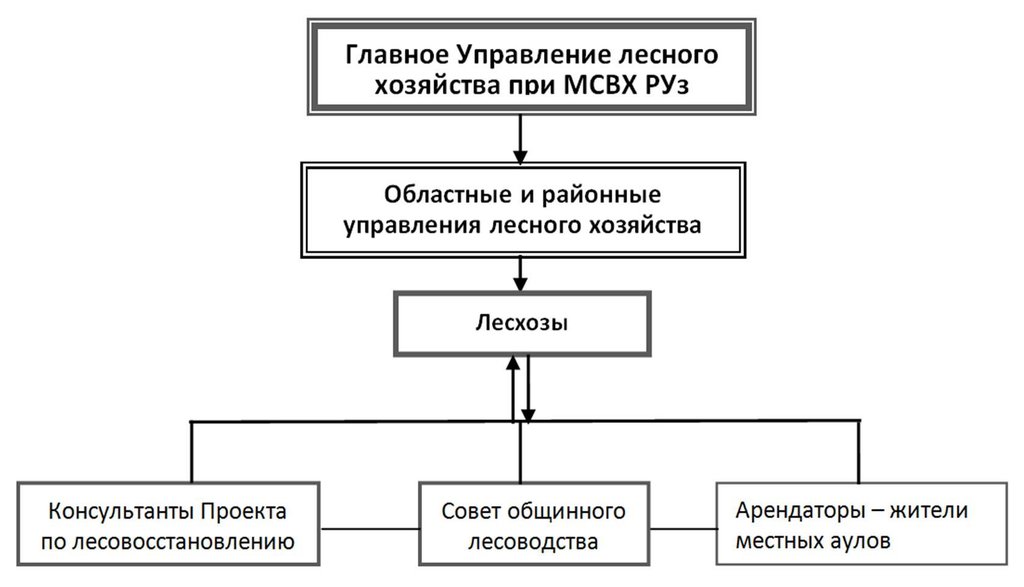Community-based forestry in Karakalpakstan [Uzbekistan]
- Creation:
- Update:
- Compiler: Tatyana Khamzina
- Editor: –
- Reviewer: Fabian Ottiger
Central Asian Countries Initiative for Land Management (CACILM)
approaches_2580 - Uzbekistan
View sections
Expand all Collapse all1. General information
1.2 Contact details of resource persons and institutions involved in the assessment and documentation of the Approach
SLM specialist:
Aybergenov Bakhytbay
(+99861)2242935
bahit@rambler.ru
Nukus, Berdakh Guzari str
Uzbekistan
Name of the institution(s) which facilitated the documentation/ evaluation of the Approach (if relevant)
Central Asian Countries Initiative for Sustainable Land Management - Multicountry Capacity Building (CACILM - MCB) - Kyrgyzstan1.3 Conditions regarding the use of data documented through WOCAT
The compiler and key resource person(s) accept the conditions regarding the use of data documented through WOCAT:
Yes
2. Description of the SLM Approach
2.1 Short description of the Approach
The local community created with support of forestry community were involved in the reforestation of degraded areas, belonging to forestry (in the frame of CACILM).
2.2 Detailed description of the Approach
Detailed description of the Approach:
Aims / objectives: Community-based forestry is aimed at preserving and restoring woodlands and reducing the threat of a loss of biodiversity through improving the forest resources management system by involving local residents in the forest restoration activities.
Methods: Under the framework of the UNDP/GEF project “Conservation of Tugai Forest and Strengthening Protected Area Systems in the Amudarya Delta of Karakalpakstan,” the local population became involved in forest restoration by renting the degraded forest areas for a duration of 5 years based on a contract signed with the forestry. In the future, subject to the fulfilment of all contractual obligations, duration of the lease is to be extended for up to 10 years. Tenants plant trees, care after the plantations and cultivate vegetable and forage crops in the inter-row space, using the yield as reward for work on restoration of degraded areas, while outputs of tree plantations is shared 50/50 between tenants and the forestry farm.
Stages of implementation: Implementation of the community-based forestry component began in 2007. First step of the UNDP national consultants was to evaluate the existing situation. Jointly with representatives of local forestry, they identified degraded forest areas. Then, with the help of the local administration, training workshops were organized for rural population.
Plots of degraded land of the forestry departments were rented to the local residents on a contractual basis. To provide tenants with a secure guarantee for the efficacy of the contractual terms over the duration of the lease, created Community Forestry Councils and adopted their charters. A Community Forestry Council is a public non-governmental organization working on a voluntary basis, its role is to ensure that both interests of the state (represented by forestry) and the tenants are duly respected. Council representatives, jointly with direct participants of the contract, participate in discussions and taking of decisions in the course of community based forest restoration.
Role of stakeholders:
1.The Government of Karakalpakstan, the UNDP/GEF project initiated the approach and is managing the restoration of tugai forests of Karakalpakstan
2.Forestry, as landlords, rent land to the local residents
3.Tenants, the local residents, restore the forest plantation, care for the plants and cultivate melons and vegetables, as well as forage crops in the inter-row space for their own profit.
4.The Community Forestry Council and staff of the nature protecting organizations participate in the coordination and dialogue between the forestry and tenants.
2.3 Photos of the Approach
2.5 Country/ region/ locations where the Approach has been applied
Country:
Uzbekistan
Region/ State/ Province:
Uzbekistan/ Karakalpakstan
Further specification of location:
Beruniy, Amudarya, Kanlykul districts
Map
×2.6 Dates of initiation and termination of the Approach
Indicate year of initiation:
2007
Year of termination (if Approach is no longer applied):
2010
2.7 Type of Approach
- project/ programme based
2.8 Main aims/ objectives of the Approach
The Approach focused mainly on other activities than SLM (Community-based forestry, forest restoration activities, local community, tenants, local administration, joint forestry management).
Community-based forestry is aimed at improving the condition of forest resources and the living standard of people who directly depend on them, as well as reducing public expenditures on forest restoration activities through the involvement of the local population in the process of forest management.
The SLM Approach addressed the following problems: The approach is applicable when the forestry departments (owners of the land) do not have sufficient resources for forest restoration.
2.9 Conditions enabling or hindering implementation of the Technology/ Technologies applied under the Approach
legal framework (land tenure, land and water use rights)
- hindering
The local population is not interested in the preservation and restoration of forest due to an absence of land ownership rights.
Treatment through the SLM Approach:
1.Provision of the local residents’ right to generate revenue from the use of land & forest resources based on the rent.
2.Provision of long-term rent.
3.Ensuring observance of state authority’s commitments.
4.Increasing population knowledge level.
The existing land ownership, land use rights / water rights greatly hindered the approach implementation Land is owned by the state (in this case, owned by the forestry departments). According to the law «On forest», only degraded land of the State forest fund may be rented. Normally, the State Forestry Department only signs short-term lease agreements (for 1 year) for land areas to private individuals and business entities under condition that the state would receive 70% of income (monetarily or in-kind).
3. Participation and roles of stakeholders involved
3.1 Stakeholders involved in the Approach and their roles
- local land users/ local communities
Middle-aged men and their families from among the local population, regardless of nationality. Community-based forestry is a family business
Traditional relations: the man is the head of the family and main bread winner. Mostly men of productive regardless of nationality. Material interest in this activity was the main method of promoting participation.
- national government (planners, decision-makers)
- international organization
The community-based forest rehabilitation approach is implemented within the framework of the Republic of Karakalpakstan, UNDP and GEF project
- All layers of society (farmers, teachers, housewives, pensioners, entrepreneurs, staff of nature protecting organizations, representatives of makhallia committees) as well as the forestry departments were involved.
3.2 Involvement of local land users/ local communities in the different phases of the Approach
| Involvement of local land users/ local communities | Specify who was involved and describe activities | |
|---|---|---|
| initiation/ motivation | none | During the meetings, the local community was informed of the advantages of joint forest resource management; There was frustration, and the participants were reluctant |
| planning | none | |
| implementation | external support | The population actively participated in forest restoration activities, attracted by the financial benefits from using rented land that was planned to be used for crop cultivation for their own profit |
| monitoring/ evaluation | interactive | Moved forward with the initiatives, made proposals towards the further development of forest rehabilitation During the next stages (monitoring and research) the population was actively participating but this activity was not enough for self-organization |
| Research | none |
3.3 Flow chart (if available)
Description:
Scheme of the Main Forestry Department
Author:
T. Khamzina (UZGIP Institut, 44, Navoi str, Tashkent)
3.4 Decision-making on the selection of SLM Technology/ Technologies
Specify who decided on the selection of the Technology/ Technologies to be implemented:
- mainly SLM specialists, following consultation with land users
Explain:
Project experts analyzed forest degradation issues. In the course of interaction with local residents they came to the conclusion that providing them with the guarantee of government revenues from the use of land and forest resources based on rent could solve the problem of restoration of forest lands.
Decisions on the method of implementing the SLM Technology were made by mainly by SLM specialists with consultation of land users. Project experts, with the assistance of local authorities, held consultations with private individuals and their associations and organized informational training workshops and discussions, formed the Joint Community-based Forestry Council , included representatives of different layers.
4. Technical support, capacity building, and knowledge management
4.1 Capacity building/ training
Was training provided to land users/ other stakeholders?
Yes
Specify who was trained:
- land users
If relevant, specify gender, age, status, ethnicity, etc.
All land users, regardless of nationality, age and social status
Form of training:
- farmer-to-farmer
- public meetings
Subjects covered:
Issues relating to advantages of joint forest rehabilitation, applying sustainable land and water management, methods of organic farming, water conservation technologies for crop cultivation, selection of universal timber species and methods of caring for the plantations.
4.2 Advisory service
Do land users have access to an advisory service?
Yes
Specify whether advisory service is provided:
- at permanent centres
Describe/ comments:
Name of method used for advisory service: Interactive; Key elements: Information/training workshops, Public gatherings and discussions
Currently, the country doesn’t have any permanent public extension services for soil and water conservation
4.3 Institution strengthening (organizational development)
Have institutions been established or strengthened through the Approach?
- no
4.4 Monitoring and evaluation
Is monitoring and evaluation part of the Approach?
Yes
Comments:
Economic / production aspects were regular monitored by project staff through measurements; indicators: Project staff calculated the income of the tenant at the end of each vegetation season
There were no changes in the Approach as a result of monitoring and evaluation
5. Financing and external material support
5.1 Annual budget for the SLM component of the Approach
If precise annual budget is not known, indicate range:
- 2,000-10,000
Comments (e.g. main sources of funding/ major donors):
Approach costs were met by the following donors: international: 100.0%
5.2 Financial/ material support provided to land users
Did land users receive financial/ material support for implementing the Technology/ Technologies?
Yes
5.3 Subsidies for specific inputs (including labour)
- agricultural
| Specify which inputs were subsidised | To which extent | Specify subsidies |
|---|---|---|
| planting stocks | fully financed | |
- infrastructure
| Specify which inputs were subsidised | To which extent | Specify subsidies |
|---|---|---|
| pipe wells for irrigation | fully financed | |
Comments:
Проектом оказана техническая поддержка, включающая приобретение саженцев, привлечение рабочей силы из числа заинтересованных сторон для посадки, установку 5 трубчатых колодцев для полива, повышение уровня знаний в области лесоводства, ирригации.
5.4 Credit
Was credit provided under the Approach for SLM activities?
No
6. Impact analysis and concluding statements
6.1 Impacts of the Approach
Did the Approach help land users to implement and maintain SLM Technologies?
- No
- Yes, little
- Yes, moderately
- Yes, greatly
Degraded forest areas, land with a virtually bare surface, turned into agro forestry plantations with trees and perennial agricultural crops growing in the inter-row space. The land began generating income, soil quality and productivity improved
Did the Approach empower socially and economically disadvantaged groups?
- No
- Yes, little
- Yes, moderately
- Yes, greatly
Renting the land increases employment of population. Men of productive age regardless of the nationality
Did the Approach improve issues of land tenure/ user rights that hindered implementation of SLM Technologies?
- No
- Yes, little
- Yes, moderately
- Yes, greatly
The problem may only be addressed by amending the law on land ownership The problem is unlikely to be overcome in the near future.
Did other land users / projects adopt the Approach?
- No
- Yes, little
- Yes, moderately
- Yes, greatly
This method was applied for the first time in 2004 under the auspices of the UNDP and Government of Uzbekistan project “Creating Nuratau – Kyzylkum biosphere reserve” in a 75 ha area. In 2007, the project “Conservation of Tugai Forest and Strengthening Protected Area System in the Amudarya Delta of Karakalpakstan” replicated this approach.
Did the Approach lead to improved livelihoods / human well-being?
- No
- Yes, little
- Yes, moderately
- Yes, greatly
Rented land is used for private purposes: growing of various crops in the tree plantation’s inter-row space to generate income for the family.
Did the Approach help to alleviate poverty?
- No
- Yes, little
- Yes, moderately
- Yes, greatly
Community members who did not have permanent employment or land moved into the category of citizens involved in agricultural production and obtained a permanent source of income.
6.2 Main motivation of land users to implement SLM
- affiliation to movement/ project/ group/ networks
В определенной степени для молодых семей престижно
- well-being and livelihoods improvement
Отсутствие постоянного источника дохода определило выбор
6.3 Sustainability of Approach activities
Can the land users sustain what has been implemented through the Approach (without external support)?
- no
If no or uncertain, specify and comment:
The local administration’s support is required to facilitate the provision of plots of land legally owned by the forestry department to the local residents
6.4 Strengths/ advantages of the Approach
| Strengths/ advantages/ opportunities in the land user’s view |
|---|
| Savings in the state budget for the protection and restoration of forests |
| No need for large investments |
| Forest restored in the rented land doesn’t need forestry department staff’s protection |
| Strengths/ advantages/ opportunities in the compiler’s or other key resource person’s view |
|---|
| Strengthening of social bonds (between the people, economy and public policy) |
| Formation of personal and social responsibility for the condition of the forests among local residents |
| Improved livelihoods for families participating in community forest restoration |
| Provision of self-employment to the local residents (81% of those involved in community forest restoration didn’t have permanent employment) |
| Agreement of mutual benefit for the stakeholders |
| The possibility of quick income from use of inter-row space |
| A stable source of income |
| Взаимовыгодность соглашения заинтересованных сторон (How to sustain/ enhance this strength: Предоставление государственной гарантии прав местным жителям на получение дохода от пользования земельными и лесными ресурсами на основе аренды обеспечит их участие в лесовосстановлении) |
6.5 Weaknesses/ disadvantages of the Approach and ways of overcoming them
| Weaknesses/ disadvantages/ risks in the land user’s view | How can they be overcome? |
|---|---|
| Renting of the forest departments’ land to the local residents is not supported by existing laws | |
| The responsibilities of stakeholders are not defined | The scale of implementation of community-based forestry is determined by the readiness of the State Department of Forestry to employ the approach and use public policy mechanisms (i.e., by the government support in the form of resolutions providing the legal framework for leasing the forestry departments’ land to local residents for their use). Creation of a public extension services system dealing with the dissemination of agricultural knowledge in rural areas |
| Forestry departments are not yet ready for decentralization of control |
| Weaknesses/ disadvantages/ risks in the compiler’s or other key resource person’s view | How can they be overcome? |
|---|---|
| Irrigation is complicated due to a lack of nearby water sources | Масштаб распространения общинного лесоводства определяется степенью готовности Государственного управления лесного хозяйства взять на вооружение подход и использовать механизмы государственной политики (то есть, поддержка со стороны правительства в виде постановлений, чтобы узаконить передачу земли лесхозов в пользование местным жителям на условиях аренды). Создание системы государственных услуг по распространению сельскохозяйственных знаний в сельской местности |
| Not sure that the new relations are stable | |
| Не узаконена передача в аренду земли лесхозов в пользование местными жителями |
7. References and links
7.1 Methods/ sources of information
- field visits, field surveys
- interviews with land users
7.2 References to available publications
Title, author, year, ISBN:
Newsletter №3, October 2008
Available from where? Costs?
www.tugai.uz
Links and modules
Expand all Collapse allLinks
No links
Modules
No modules


